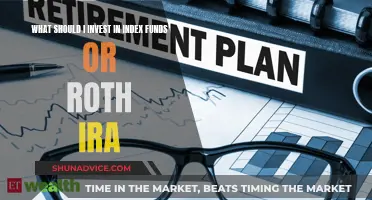
Investing in funds is a great way to build a diversified portfolio without the extra cost or hassle of buying and selling individual stocks. Funds are a collective investment vehicle where your money is pooled with that of other investors and spread across a wide range of underlying investments, providing instant diversification and reducing risk.
There are different types of funds, including mutual funds, exchange-traded funds (ETFs), money market funds, and hedge funds. When investing in funds, you need to consider your financial goals, risk tolerance, fees, and the fund's management style. It is recommended to invest for the long term, typically at least five years, to ride out any bumps in the market.
Before investing, it is important to understand the different types of funds, conduct thorough research, and carefully consider your financial goals and risk tolerance.
What You'll Learn

Understand the differences between unit trusts, open-ended investment companies (OEICs) and investment trusts
Unit trusts, open-ended investment companies (OEICs), and investment trusts are three types of investment funds with distinct features.
Unit trusts and OEICs are both ""open-ended," meaning that the fund manager can create more units (like shares) whenever there is a demand from investors. The price of each unit (unit trust) or share (OEIC) depends on the net asset value (NAV) of the fund's investment portfolio. Unit trusts and OEICs are also similar in that they can both invest in a wide range of asset classes, geographies, and sectors.
However, there are some key differences between unit trusts and OEICs. Unit trusts are governed by trust law, while OEICs are governed by company law. This means that, technically, investors in a unit trust do not own the underlying assets, whereas investors in an OEIC do. The other major difference is in pricing. Unit trusts have a bid price (to redeem) and an offer price (when you buy), whereas OEICs only quote one price per day, based on the NAV of the underlying assets of the fund. OEICs tend to have lower fees than unit trusts because they have a simpler structure.
Investment trusts differ from unit trusts and OEICs in that they are "closed-ended" funds. This means that they issue a fixed number of non-redeemable shares.
Single Investment Strategies to Fund Your Future
You may want to see also

Decide on your investment goals and risk tolerance
Before investing in a fund, it is crucial to define your investment goals and risk tolerance. This involves considering your financial objectives, time horizon, and comfort level with potential losses. Here are some factors to help you decide on your investment goals and risk tolerance:
Financial Goals
Determine what you want to achieve by investing in mutual funds. Are you saving for retirement, your child's education, buying a home, or some other goal? Clarifying your financial goals will help you choose the right types of funds and investment strategies.
Time Horizon
Consider how long you plan to invest for. Are your goals decades away, or do you need the money in a few years? If you have a long-term horizon, you can consider investing a larger portion of your portfolio in stock-based mutual funds, which tend to offer higher potential returns but come with higher risk. For shorter-term goals, you might opt for more conservative investments, such as bond funds or high-yield savings accounts.
Risk Tolerance
Risk tolerance refers to how comfortable you are with potential losses in your investments. It's essential to be honest with yourself about your risk tolerance to ensure you don't take on more risk than you can handle. If investing heavily in stocks makes you anxious, consider a more balanced approach or focus on less risky investments. Remember, higher returns usually come with higher risk, so carefully assess your ability to tolerate potential losses.
Investment Strategy
Based on your goals and risk tolerance, you can choose between actively managed funds and passively managed funds (index funds). Actively managed funds aim to beat the market performance and usually come with higher fees. Passively managed funds, on the other hand, aim to replicate the performance of a specific market index and typically have lower fees. Consider whether you want to try to outperform the market or simply match its performance.
Fees and Costs
When deciding on your investment goals and risk tolerance, don't forget to factor in the fees and costs associated with investing in mutual funds. These include expense ratios, load fees, and management fees. Higher fees can eat into your investment returns over time, so it's crucial to keep them as low as possible.
Diversification
Diversifying your investments across different asset classes and sectors can help reduce risk. By investing in a variety of funds, you lower the impact of any single investment on your portfolio. Diversification can smooth out returns and potentially enhance your overall investment performance.
In conclusion, deciding on your investment goals and risk tolerance involves a careful assessment of your financial objectives, time horizon, risk comfort level, investment strategy preferences, fees, and diversification. Taking the time to consider these factors will help you make more informed investment decisions and create a portfolio that aligns with your goals and risk profile.
Maximizing Your HSA Investments with WageWorks: A Guide
You may want to see also

Pick the right fund strategy for your goals
When it comes to investing in mutual funds, there are several factors to consider to ensure that you are picking the right fund strategy for your goals.
Firstly, it is important to understand the different types of funds available. Actively managed funds, for instance, aim to beat the market and are managed by professionals who actively research and decide which securities to invest in. On the other hand, passive investing involves less active management and often entails lower fees. Index funds and ETFs are examples of passive investing, where the goal is to mimic the performance of a specific market index.
Another factor to consider is your risk tolerance and investment goals. If you are investing for the long term, such as for retirement, you may want to allocate a larger portion of your portfolio to stock-based mutual funds, which have the potential for higher returns but also come with higher risk. If you are saving for a shorter-term goal, such as buying a home or a car, you might prefer a more conservative approach, such as investing in bond market mutual funds or high-yield savings accounts.
Additionally, you should research the fees associated with different funds. Expense ratios, management fees, and load fees can eat into your returns over time, so it is important to consider these costs when selecting a fund.
Finally, it is crucial to diversify your investments to minimise risk. Investing in a variety of assets, sectors, and markets can help spread out your risk and smooth out returns over time.
By carefully considering these factors and doing your research, you can pick the right fund strategy that aligns with your financial goals and risk tolerance.
Vanguard Bond Fund: A Smart Investment Decision
You may want to see also

Research potential funds
Researching potential funds is an important part of an investor's due diligence. Here are some ways to research potential funds:
Use a Research Platform
A research platform can provide a wealth of information, such as quotes for individual stocks, company financial statements, key company statistics, and more. Even advanced investors and traders may be surprised by the extensive tools and resources that can be found on a particular platform. For example, Fidelity.com offers a powerful research platform that provides information not only on stocks but also on sectors and industries, exchange-traded funds (ETFs), mutual funds, bonds, options, IPOs, and annuities.
Assess the Fundamentals and Technicals
Fundamental analysis involves evaluating a company's business performance and competitive positioning, such as revenues, expenses, earnings, and cash flow. This information can be found on websites like Fidelity.com. Another method of analysis is technical analysis, which involves looking at charts to try to detect tradable patterns. This can be done on platforms like Active Trader Pro®.
News and Research Reports
Being aware of potentially market-moving news can be crucial when deciding whether to buy or sell a stock. Major news reports and analyst research reports can significantly impact stock prices. Analyst research reports are especially valuable, as analysts spend their working time evaluating stocks and have a good understanding of companies. Their views often carry significant weight, and they can move a stock with their recommendations alone.
Stock Screeners
A stock screener is a tool that can help you quickly find investment candidates by sorting through the market based on an array of characteristics. While screeners are powerful tools, they do not replace the need for further analysis. They simply act as an efficient vehicle to look for opportunities in the market that meet your desired objectives and risk tolerance.
Talk to Management Teams
While it may seem like management teams are off-limits to individual investors, it is possible to get in touch with smaller firms, where executives will speak with current or future investors. Prepare pertinent questions that show you know the business, and use this opportunity to ask insiders for more insights. Even if you can't reach the top brass, you can access a public company's investor relations department, which can provide financial details or perspectives on press releases.
Do Your Own First-Hand Research
Getting out from behind the desk and observing new trends emerging firsthand is a classic piece of advice from investing legend Peter Lynch. Keep an eye out for new products or services that are gaining popularity with your friends or in your area. Check them out yourself and assess whether the business is running smoothly. This approach is great for finding hot new consumer brands, especially in the restaurant or retail spaces.
Run Your Own Channel Checks
For consumer or retail brands, you can do what Wall Street analysts call "channel checks," which involve seeing how much product is moving through the system. In the case of individual investors, you can ask questions such as whether a new product is getting shelf space at your local grocery store or whether the parking lot at a hot new chain restaurant is getting more or less crowded over time.
How to Choose a Qualified Opportunity Fund for Investing
You may want to see also

Understand the fees and charges
Fees and charges are an important consideration when investing in funds. Here are some key points to understand:
Types of Fees
There are typically two types of fees associated with investing in funds: charges by the platform and costs for each fund you hold.
Platform Charges:
- Account Fee: This could be a monthly, quarterly, or annual fee, either charged as a flat rate or a percentage of your investments.
- Buying/Selling Funds: There may be a fee each time you buy or sell a fund, but frequent traders often get discounts.
- Transfer-out Fee: Some platforms charge a fee if you want to transfer your investments to another provider or close your account.
Fund Costs:
Fund Manager/Annual Management Charge: This is a percentage fee calculated yearly. Expect fees of around 1% for actively managed funds and less for passive tracker funds.
Impact on Returns
Fees can significantly impact your investment returns over time. It is important to understand the fees associated with the funds you are considering and choose funds with lower fees when possible.
Drip-Feeding
Instead of investing a large sum all at once, consider "drip-feeding" by investing smaller amounts regularly. This can help smooth out the ups and downs of the market and reduce the risk of losing money.
Avoid Unnecessary Fees
Be cautious of platforms or funds with high fees, as these can eat into your investment returns. Also, be wary of scams and cold callers offering investment opportunities. It is usually best to say no to these offers, as they are often fraudulent.
Research and Compare
Before investing, be sure to research and compare different platforms and funds to find the most cost-effective options. Look for platforms with low account fees and frequent trader discounts. When choosing funds, consider passive tracker funds, which typically have lower fees than actively managed funds.
Smart Mutual Fund Investment Strategies for Your 1 Crore
You may want to see also
Frequently asked questions
An investment fund is a supply of capital from multiple investors, used to purchase securities. Each investor retains ownership and control of their shares. Investment funds provide a broader selection of investment opportunities, greater management expertise, and lower investment fees than investors might be able to obtain on their own.
Types of investment funds include mutual funds, exchange-traded funds (ETFs), money market funds, and hedge funds. Mutual funds are the most common type, while ETFs are similar to mutual funds but are traded on exchanges and often have lower expense ratios. Hedge funds are actively managed and available only to accredited investors, allowing them to invest in a wider range of asset classes.
Investing in funds offers the advantage of diversification, as your money is spread across multiple assets. Fund managers provide expertise and time in researching and selecting investment opportunities. Funds also tend to have lower investment fees compared to individual investors acting alone.







